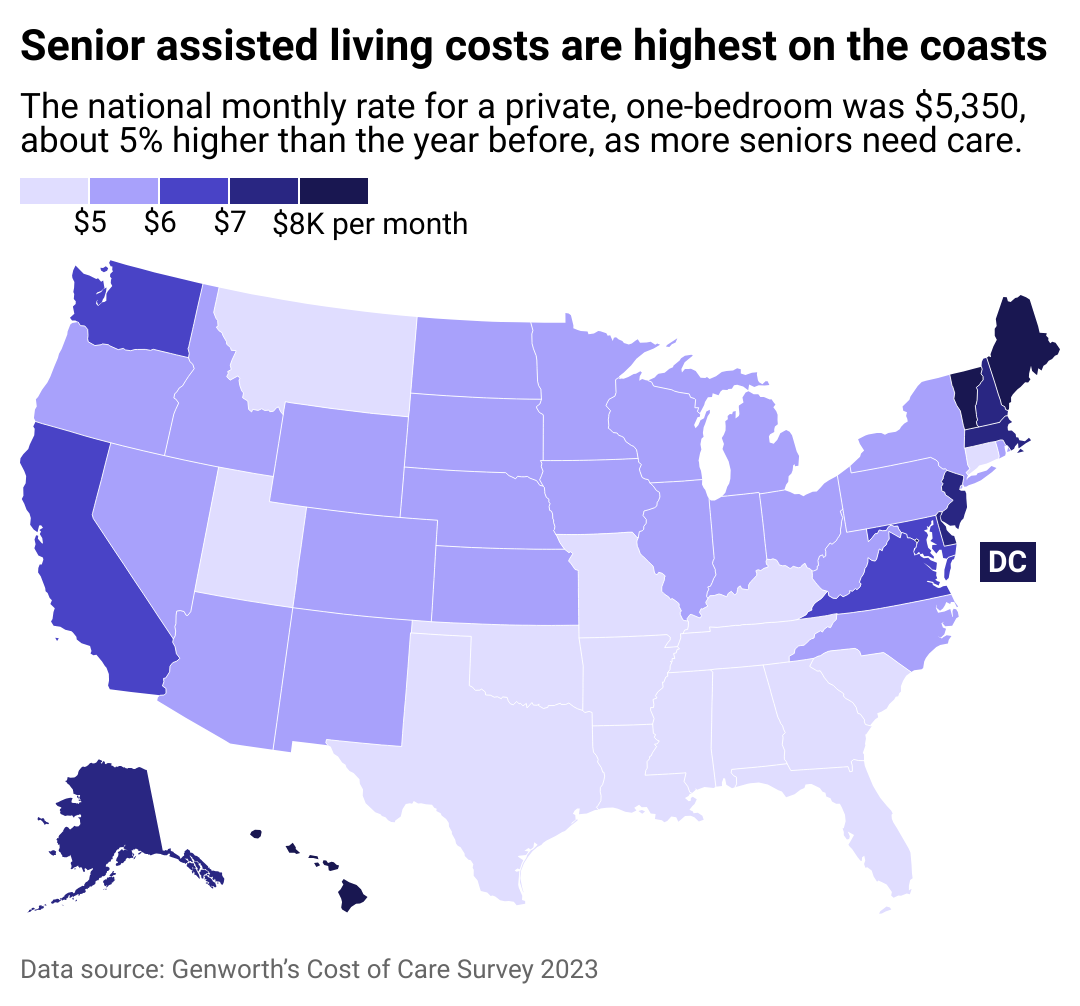QMedic examined data from the Genworth Cost of Care Survey and the NCAL to determine the cost of senior assisted living in different states.
This item is available in full to subscribers.
To continue reading, you will need to either log in to your subscriber account, below, or purchase a new subscription.
Please log in to continue |

More than 800,000 adults in the U.S. reside in an assisted living facility, according to the American Health Care Association, but the number of facilities and average costs vary widely from state to state. This issue is becoming increasingly important among the aging population, which has been rapidly growing since 2010.
To investigate what goes into the cost of assisted living, QMedic examined data from the Genworth Cost of Care Survey and the National Center for Assisted Living.
People 65 and older now account for 16.8% of the total population in 2020. Many members of this older group need extra support to live comfortably and stay safe, even though a majority have expressed the desire to age in place. A 2021 national poll conducted by AARP found that about 3 in 4 respondents who were at least 50 years old would like to stay in their current homes as long as possible. Some may have this option with support from family or friends, but others may require help offered by residential facilities such as an assisted living facility.
An assisted living facility supports residents with daily activities like bathing, dressing, or keeping track of medications, but doesn't include some of the more specific services found at a nursing home. Nursing home services focus more on medical care, such as providing physical, occupational, or speech therapy. It is a long-term solution for those who want to remain in a homelike setting, but it comes with a cost. This type of care usually costs more than living in one's home independently but is still less expensive than a nursing home.
The average cost of assisted living in the United States is $5,350 per month or $64,200 annually for a private, one-bedroom arrangement, according to Genworth's 2023 Cost of Care Survey. The cost of these facilities increased an average of 18.89% from 2021, though only 1.36% when comparing 2022 to 2023. This increase was driven by inflation and a shortage of workers, noted Genworth.

Assisted living facilities and the fees associated with them are regulated at a state level, so the cost and scope of services vary widely depending on where in the country you live. When a person signs on for a facility, it typically comes with a move-in fee and a monthly rent. Residents also pay for add-ons like physical therapy, laundry services, or transportation.
Charges can also occur the more one needs help with daily activities such as bathing, dressing, or going to the bathroom. Some facilities also offer memory care programs for people with Alzheimer's disease or dementia, which again means additional fees. All of these activities require caregivers, which assisted living communities currently lack—and the scramble is also hurting residents' pockets.
Four out of 5 assisted living communities reported facing staff shortages in 2021, according to a survey of 122 assisted living communities from the American Health Care Association and National Center for Assisted Living. As a result, many communities have started offering higher wages and more benefits to help attract skilled workers, bumping up costs for residents.
Another factor to consider when calculating the bill is the cost of living in the state where the facility is located. The cost of living is the amount of money people need to cover basic expenses like food, transportation, and health care, all of which an assisted living facility provides. The higher the cost of living in the state, the higher a facility's rate typically is.
Washington D.C. tops the list for the most expensive assisted living cost at an average of $9,563 per month and just 16 beds for every 1,000 adults over 65. This isn't surprising considering the district ranks the second-highest when it comes to the cost of living among U.S. states. Hawai'i, which has the highest cost of living index among all the states, comes second in assisted living costs, at $9,340 per month and just 17 beds for every 1,000 adults over 65. Generally, coastal states attract the highest costs, with several Northeast states, Alaska ($7,250 per month), California ($6,250), and Washington ($6,138) at the top of the ranks.
On the other hand, Mississippi boasts the lowest cost for senior assisted living, at $3,800 per month and 13 beds for every 1,000 adults over 65. The state is also the least expensive place to live when taking the cost of living into account. Mississippi is followed by Georgia, at $4,120 per month and 20 beds per 1,000 adults over 65.
A critical problem shared by both the elderly community and the facilities themselves is the number of beds available competing with growing needs. In fact, across the country, there are only 43 licensed beds in assisted living facilities for every 1,000 adults over 65. This problem is only expected to get worse. According to the Census Bureau, by 2030, 1 in 5 Americans are projected to be of retirement age. The challenges around caring for the aging generation go beyond this group as the impact will affect policymakers, health care providers, and families across the country.

Given the significant costs of assisted living, paying for these services is challenging for many families. At times fees associated with long-term care can be unpredictable, given events like falls or unexpected illnesses. Overall, the level of help needed will vary from person to person, and can often change over time.
It's best to be prepared, understanding the tiers of care offered at individual facilities and how much each will cost. However, there are some misconceptions regarding who pays for assisted living. Though Medicare and Medicaid can help with some costs of care received at facilities, they will not pay for room and board. Support can be provided to veterans through VA health care but only for those who are signed up. However, for most people, assisted living costs are covered using a combination of personal assets, savings, and insurance benefits.
The best way to plan for senior living is to start before a lot of care is required. Planning ahead allows aging individuals the freedom to make decisions for their future before needs become urgent. Many services sought out by seniors can be provided with at-home care. Meals, chores, medication management, and home safety features can all be provided without having to move. This can often be the most comfortable option for elderly individuals in need of support.
Those living alone, at more advanced ages, and with a history of chronic illness or disability, are more likely to need to receive their care at assisted living facilities. Research from the Department of Health and Human Services has shown that over half of people turning 65 will develop a disability that could require long-term care services, meaning lifestyle changes or additional support could come sooner than expected for many Americans.
Story editing by Carren Jao. Additional editing by Kelly Glass. Copy editing by Tim Bruns.
This story originally appeared on QMedic and was produced and distributed in partnership with Stacker Studio.